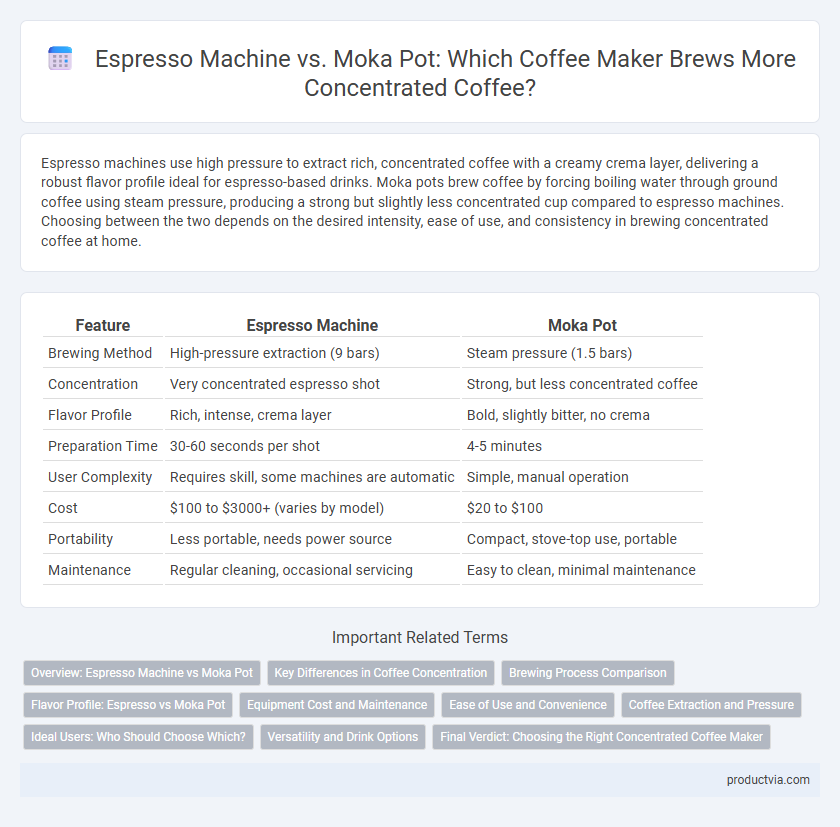Espresso machines use high pressure to extract rich, concentrated coffee with a creamy crema layer, delivering a robust flavor profile ideal for espresso-based drinks. Moka pots brew coffee by forcing boiling water through ground coffee using steam pressure, producing a strong but slightly less concentrated cup compared to espresso machines. Choosing between the two depends on the desired intensity, ease of use, and consistency in brewing concentrated coffee at home.
Table of Comparison
| Feature | Espresso Machine | Moka Pot |
|---|---|---|
| Brewing Method | High-pressure extraction (9 bars) | Steam pressure (1.5 bars) |
| Concentration | Very concentrated espresso shot | Strong, but less concentrated coffee |
| Flavor Profile | Rich, intense, crema layer | Bold, slightly bitter, no crema |
| Preparation Time | 30-60 seconds per shot | 4-5 minutes |
| User Complexity | Requires skill, some machines are automatic | Simple, manual operation |
| Cost | $100 to $3000+ (varies by model) | $20 to $100 |
| Portability | Less portable, needs power source | Compact, stove-top use, portable |
| Maintenance | Regular cleaning, occasional servicing | Easy to clean, minimal maintenance |
Overview: Espresso Machine vs Moka Pot
Espresso machines deliver high-pressure extraction at around 9 bars, producing a rich, concentrated coffee with a signature crema layer, ideal for espresso-based drinks. Moka pots use stovetop pressure, approximately 1.5 bars, to brew dense coffee with robust flavors but lack the intense crema characteristic. Comparing extraction pressure, ease of use, and flavor profile highlights the espresso machine as a premium option, while the moka pot offers affordability and traditional robustness.
Key Differences in Coffee Concentration
Espresso machines extract coffee using high pressure, producing a rich, concentrated shot with a thick crema and intense flavor. Moka pots utilize steam pressure at a lower level, resulting in a strong coffee that is less dense and slightly more bitter than espresso. The key difference lies in pressure and extraction time, with espresso machines delivering a higher concentration of coffee oils and solids for a bolder taste.
Brewing Process Comparison
Espresso machines use high-pressure extraction, forcing hot water through finely ground coffee at around 9 bars of pressure, which results in a rich crema and intense flavor concentration. Moka pots rely on steam pressure generated by boiling water to push water through coffee grounds, producing a strong but less concentrated brew compared to espresso. The espresso machine's precise temperature and pressure control yield a thicker, creamier shot, whereas the moka pot offers a more robust yet slightly less velvety cup.
Flavor Profile: Espresso vs Moka Pot
Espresso machines produce a rich, bold flavor with a creamy crema layer due to high-pressure extraction, resulting in a balanced blend of acidity, bitterness, and sweetness. Moka pots create a strong, robust coffee with a more pronounced bitterness and less crema, emphasizing deeper, roasted notes. The espresso's smooth texture contrasts with the moka pot's fuller, slightly gritty mouthfeel, appealing to different palates in concentrated coffee enjoyment.
Equipment Cost and Maintenance
Espresso machines typically require a higher initial investment, often ranging from $100 to over $1,000 depending on the model and features, while moka pots are more affordable, usually costing between $20 and $100. Maintenance for espresso machines involves regular descaling, cleaning of group heads, and occasional parts replacement, which can increase ongoing expenses. Moka pots demand minimal upkeep, primarily rinsing after use and occasional gasket replacement, making them cost-effective for concentrated coffee preparation.
Ease of Use and Convenience
Espresso machines offer precise control over brewing parameters, delivering consistent concentrated coffee with minimal effort, ideal for users seeking convenience and speed. Moka pots require manual attention and careful heat management, which can be less convenient but remain a straightforward option for traditional stovetop brewing. Choosing between the two depends on balancing ease of use and the desired level of control in producing strong, concentrated coffee.
Coffee Extraction and Pressure
Espresso machines use high pressure, typically around 9 bars, to force hot water through finely ground coffee, resulting in fast extraction and a rich, concentrated shot with crema. Moka pots rely on lower pressure generated by steam, roughly 1-2 bars, producing a strong coffee but with less crema and a longer brewing time. The higher pressure and precise control of espresso machines yield a more intense and balanced flavor profile compared to the moka pot's robust yet less refined extraction.
Ideal Users: Who Should Choose Which?
Espresso machines are ideal for coffee enthusiasts seeking quick, high-pressure extraction for a rich, crema-topped espresso shot, making them perfect for cafes and home baristas who value precision and customization. Moka pots suit users who prefer a simpler, stovetop brewing method to produce a strong, concentrated coffee without the need for electricity or complex machinery, fitting well in casual home settings or travel scenarios. Those prioritizing barista-level control and consistency should opt for espresso machines, while those favoring affordability and ease of use should choose moka pots.
Versatility and Drink Options
Espresso machines offer greater versatility with precise control over pressure and temperature, enabling a wide range of concentrated coffee drinks such as lattes, cappuccinos, and americanos. Moka pots produce strong, robust coffee with fewer customization options but excel at delivering a consistent, rich espresso-like flavor. For users seeking diverse beverage options and adjustable brewing parameters, espresso machines provide superior flexibility compared to the simpler, traditional moka pot.
Final Verdict: Choosing the Right Concentrated Coffee Maker
Espresso machines deliver rich, high-pressure extraction for authentic, barista-quality espresso with thick crema, ideal for coffee enthusiasts seeking precision and consistency. Moka pots produce strong, concentrated coffee through stovetop pressure, offering a more affordable and straightforward option with robust flavor but less crema. Selecting between the two depends on preference for professional-level quality versus convenience and cost-effectiveness in concentrated coffee preparation.
Espresso Machine vs Moka Pot for Concentrated Coffee Infographic

 productvia.com
productvia.com